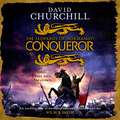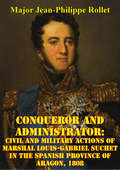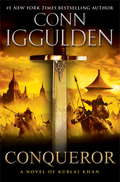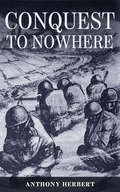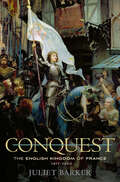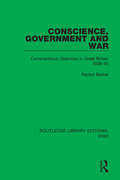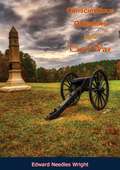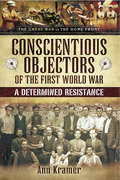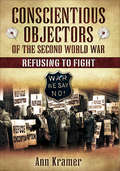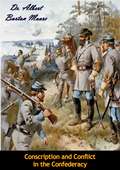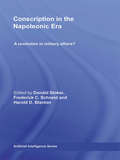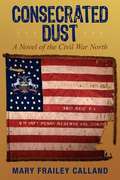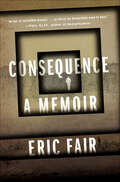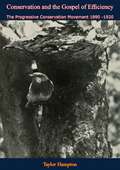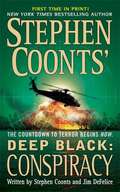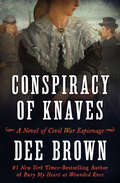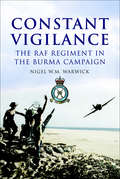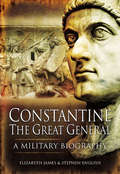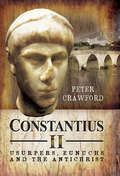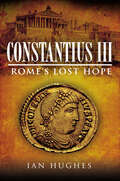- Table View
- List View
Conqueror (Leopards of Normandy 3): The ultimate battle is here
by David Churchill**From the co-author of the No.1 bestselling Wilbur Smith novel, WAR CRY. **The Leopards of Normandy trilogy concludes with Conqueror as Duke William prepares to take England, and his rivals for the English throne, by storm. It begins in Normandy. It will end at Hastings. This vibrant series by David Churchill, co-author of War Cry, the upcoming Courtney novel by Wilbur Smith, is a must-read for fans of Bernard Cornwell and Conn Iggulden. 'An exciting mix of medieval betrayal, violence and sex' Wilbur Smith.It began with a promise. It will end at Hastings.William of Normandy, sworn heir to the English throne, is no longer the boy Duke but a loyal and proven warrior. Few dare challenge him, but England is an irresistible prize.The handsome, ambitious Harold Godwinson and the Viking Hardrada are both determined to stake a claim. William faces his greatest ever battle: deny his own destiny or conquer the land he was born to rule.History will be written in the blood of those who fall.(P)2018 Headline Publishing Group Ltd
Conqueror And Administrator: Civil And Military Actions Of Marshal Louis-Gabriel Suchet In The Spanish Province Of Aragon, 1808
by Major Jean-Philippe RolletDuring the Peninsular War in Spain from 1808 to 1813, Marshal Suchet not only successfully fought the Spanish "Guerillas" but he also skilfully administrated the province of Aragon. He made it a relatively safe and prosperous place for his troops, while the rest of Spain became a nightmarish quagmire for the French occupiers.In early 1808, Napoleon, under the pretext of a dispute between the Spanish King Charles IV and his son Ferdinand, invaded Spain. His troops were at first greeted as liberators by the populace, who wanted to be rid of King Charles' Prime Minister Manuel de Godoy. As it became clearer that Napoleon's intentions were to take control of the Spanish kingdom and to crown his own brother, Joseph, as King, the people of Spain revolted. Appointed the governor of the insurgency-troubled province of Aragon after he had seized its main cities, Marshall Suchet skilfully adopted a balanced policy mixing strong military action and economic reforms to regenerate the local economy. He also adopted political measures aimed at restoring the appearance of a Spanish sovereignty. At the operational level, Suchet restored the discipline of III Corps and developed a network of strong places that ensured a French armed presence throughout the region while relying on highly mobile autonomous units to chase the guerrillas in their strongholds. An astute economist, he succeeded in developing the local economy, while also establishing a mutual beneficial relationship between his troops and the populace. Politically and culturally aware of the Spanish situation, he utilized the specificities of the Aragonese people to thwart the influence of the guerrilla leaders. He eventually established a flexible policy based on a mix of benevolence and coercion. During his administration, Aragon remained a relatively safe place, with a sustainable economy and, above all, one where the French soldiers and the population could mix and establish contacts.
Conqueror: A Novel of Kublai Khan (Conqueror #5)
by Conn IgguldenIntrigue and treachery roil the vast Mongol nation as the heirs of Genghis Khan fight for control of his unprecedented empire--and of his mighty armies. History will turn on the outcome of their struggle. But only one man, dismissed by all the others, will boldly rise to the challenge with the courage and vision to forge the future, and with the strength to be called . . . CONQUEROR The novels of Conn Iggulden bring the past to thrilling life, from ancient Rome to thirteenth-century Asia, Europe, and the Middle East. Now he delivers the spectacular story of the rise of Genghis Khan's grandson, a man destined to become one of the most remarkable rulers who ever lived--the legendary Kublai Khan. A succession of ruthless leaders has seized power in the wake of the great Khan's death--all descendants of Genghis, but none with the indomitable character that led a people to triumph. One grandson, Guyuk, decadent and vicious, seeks to consolidate his position through bribery and murder, pitting powerful factions against one another and straining the loyalties of the tribes to the breaking point. Next comes his cousin, Mongke, who eliminates all possible opposition with breathtaking brutality and dispatches his younger brothers Kublai and Hulegu to far-flung territories, to test their mettle and their allegiance. Hulegu displays his barbarity with the savage destruction of Baghdad and his clash with the Khan's age-old enemies, the cult of assassins, who will strike deep into the heart of the nation. But it is Kublai--refined and scholarly, always considered too thoughtful to take power--who will devise new ways of warfare and conquest as he builds the dream city of Xanadu and pursues the ultimate prize: the ancient empire of Sung China. His gifts will serve him well when an epic civil war breaks out among brothers, the outcome of which will literally change the world. Brilliantly researched and imagined, unforgettably told, Conqueror is a magnificent achievement from an enthralling writer at the peak of his powers, a must read for all lovers of history and storytelling on the grand scale.From the Hardcover edition.
Conquest In Cyberspace: National Security And Information Warfare
by Martin C. LibickiModern societies and militaries, both pervaded by computers, are supposedly at risk. As Conquest in Cyberspace explains, however, information systems and information itself are too easily conflated, and persistent mastery over the former is difficult to achieve. The author also investigates how far 'friendly conquest' in cyberspace extends, such as the power to persuade users to adopt new points of view. He discusses the role of public policy in managing cyberspace conquests and shows how the Internet is becoming more ubiquitous and complex, such as in the use of artificial intelligence.
Conquest to Nowhere: An Infantryman In Wartime Korea
by Anthony Herbert Robert NiemannConquest to Nowhere, first published in 1955, is author Anthony Herbert’s account of his harrowing time in Korea in 1950-51. Herbert, wounded numerous times, became America’s most decorated soldier of the Korean conflict. He tells a gritty, heart-wrenching story of dangerous patrols, battles against overwhelming Chinese assaults, the anguish of losing comrades-in arms, and his personal struggles to simply survive. Herbert continued his military service in Vietnam where he attained the rank of lieutenant-colonel. Included are several illustrations from the original book.
Conquest: The English Kingdom of France, 1417–1450
by Juliet BarkerThis history of the Hundred Years War vividly chronicles the all-but-forgotten period when England ruled a great swath of France at the point of a sword. Following the Battle of Agincourt, Henry V&’s second invasion of France in 1417 launched a campaign that would place the crown of France on an English head. By the time of Henry&’s premature death in 1422, nearly all of northern France lay in his hands and the Valois heir to the throne had been disinherited. Only Joan of Arc—a visionary peasant girl who claimed divine guidance—was able to halt the English advance, but not for long. Just six months after her death, Henry&’s young son was crowned in Paris as the first, and last, English king of France. Henry VI&’s kingdom endured for twenty years, but when he came of age he was not the leader his father had been. The dauphin whom Joan had crowned Charles VII would finally drive the English out of France. Juliet Barker recounts these stirring events—the epic battles and sieges, plots and betrayals—through a kaleidoscope of characters from John Talbot, the &“English Achilles,&” and John, duke of Bedford, regent of France, to brutal mercenaries, opportunistic freebooters, resourceful spies, and lovers torn apart by the conflict.
Conscience and Courage: Rescuers of Jews During the Holocaust
by Eva FogelmanIn this brilliantly researched and insightful book, psychologist Eva Fogelman presents compelling stories of rescuers of Jews during the Holocaust--and offers a revealing analysis of their motivations. Based on her extensive experience as a therapist treating Jewish survivors of the Holocaust and those who helped them, Fogelman delves into the psychology of altruism, illuminating why these rescuers chose to act while others simply stood by. While analyzing motivations, Conscience And Courage tells the stories of such little-known individuals as Stefnaia Podgorska Burzminska, a Polish teenager who hid thirteen Jews in her home; Alexander Roslan, a dealer in the black market who kept uprooting his family to shelter three Jewish children in his care, as well as more heralded individuals such as Oskar Schindler, Raoul Wallenberg, and Miep Gies. Speaking to the same audience that flocked to Steven Spielberg's Academy Award-winning movie, Schindler's List, Conscience And Courage is the first book to go beyond the stories to answer the question: Why did they help?From the Trade Paperback edition.
Conscience, Government and War: Conscientious Objection in Great Britain 1939–45 (Routledge Library Editions: WW2 #6)
by Rachel BarkerThis book, first published in 1982, is a systematic and detached analysis of the 60,000 British conscientious objectors in the Second World War, forming an examination of the relationship between the individual and the State in time of war. It sets out to show how the British Government dealt with the challenge that conscientious objectors posed and how far it was able to correct the abuses and injustices that occurred in the First World War. It traces the background of pacifism between the Wars and the introduction of conscription, and gives a detailed account of the functioning of the Conscientious Objectors’ Tribunals and an assessment of their work. It goes on to examine the reactions and attitudes of Tribunal members, employers and the rest of the population, and how these were affected by the Government lead. It recounts the experience of objectors in civilian life and private and public employment, and how they fared in the armed forces and prisons. It also assesses the contributions made by the voluntary organisations who helped conscientious objectors in the war.
Conscientious Objectors in the Civil War
by Edward Needles WrightThe term “conscientious objector” was not in use during the Civil War, but the concept certainly existed. This engrossing volume is an authoritative, thoroughly researched study of the whole problem of objection to warfare on religious or moral grounds, as it existed during the Civil War. The author covers five major areas: the types of individuals and which religious denominations were actually opposed to the war on conscientious grounds; what efforts were made on behalf of objectors and what changes took place in their political status; the attitude of the civil and military authorities toward objectors; the number of objectors; and, finally, a comparison of the problem of conscientious objection in the Civil War with the same problem as it existed for the United States during the First World War.The facts presented in this volume are of historical interest; the conclusions the author draws, however, are, if anything, more relevant and important today than they were during any other period in American history.
Conscientious Objectors of the First World War: A Determined Resistance (The\great War On The Home Front Ser.)
by Ann KramerThe story of conscientious objection in Britain begins in 1916, when conscription was introduced for the first time. Some 16,000 men the first conscientious objectors refused conscription because they believed on grounds of conscience that it was wrong to kill and wrong of any government to force them to do so. As historians mark the centenary of the First World War much emphasis is placed on the bravery of those men who fought and died in the trenches. But those who refused to kill were also courageous. Conscientious objectors in the First World War were treated brutally: they were seen as cowards and traitors, vilified, abused, forced into the army, brutalised and tortured. Some were even sentenced to death in an attempt to break their resistance. Many spent long months and years in prison. Nothing though that the authorities did broke the determined resistance of these men, whose deeply held principles and belief that killing was wrong carried them through and stands as a beacon for individual conscience to this day. Conscientious Objectors of the First World War: A Determined Resistance tells the stories of these remarkable men. It looks at who they were, why they took the stand they did and how they were treated. To bring their voices and experiences to life, Ann Kramer, has used extensive prime source material, including interviews, memoirs and contemporary newspapers. Working from these she describes what it was like for COs to face hostile tribunals, be forced into the army, defy army regulations, be brutalised and endure repeated terms of imprisonment. She concludes by looking at their legacy, which was profound, inspiring a second generation of conscientious objectors during the Second World War, a continuing story that Ann Kramer describes in her companion volume Conscientious Objectors of the Second World War: Refusing to Kill.
Conscientious Objectors of the Second World War: Refusing to Fight
by Ann Kramer&“Drawing on extensive primary sources, Kramer describes the inter-war peace movement that gave birth to many conscientious objectors&” (Military History Monthly). Even today, most histories of the world wars focus on those who fought. Those who refused to do so are often overlooked. It is perhaps only recently that their bravery and extraordinary principles are being recognized. In the First World War, 16,000 men in Britain became the first ever conscientious objectors, and were reviled and brutalized as a result. The conscientious objectors of the Second World War—both men and women—did not experience the same treatment as those earlier COs, but to some extent it was a harder stand to take. It was not easy to refuse to fight in the face of Nazism and Fascism, when large areas of Europe were occupied and when almost the entire British population was organized for total war. Conscientious Objectors of the Second World War: Refusing to Fight tells the stories of these remarkable men and women who bravely took a stand and refused to be conscripted. To bring this fascinating subject to life, Ann Kramer has used extensive prime sources, such as interviews, memoirs, contemporary newspaper accounts, letters, and diaries. Working from these and other sources, she asks who these men and women were who refused conscription and killing, what their reasons were for being conscientious objectors, and how they were treated. The book finishes by exploring their achievements and impact, suggesting that their principles and influence continue to this day. &“[Kramer shows] conscientious objectors in all their infinite variety.&” —Peace News
Conscription and Conflict in the Confederacy
by Dr Albert Burton MooreThis volume deals with the conscription system in the Confederacy and the conflicts which it produced between Confederate and State authorities. It was begun with a view to discovering the effect of conscription upon the course of the war and to making available the experiences of the Confederacy, hard pressed always for fighting men, in raising its armies. I have endeavored to tell a true story, as it is revealed by the Official Records, newspapers and other source materials, and by the memories of living men and women.My chief sources of information have been the Official Records of the War and contemporary newspapers; however, I have found the Journals of Congress very useful. The Official Records contain an abundance of reliable information concerning the workings of conscription, especially in the States east of the Mississippi. Were personal records and newspapers more copious, color here and there might be added to the narrative, but it is hoped, and confidently believed, that the essential truths have been discovered and presented. If there was much dereliction among those of conscript age, contrary to prevalent notions North and South, it serves to set in a brighter light the heroism and sacrifices of the masses.If I have succeeded in making available to our leaders the extensive experiments of the Confederacy with conscription and presenting acceptably to the students of history a neglected chapter of our military and constitutional history, I shall consider myself amply compensated for my toils.
Conscription in the Napoleonic Era: A Revolution in Military Affairs? (Cass Military Studies)
by Frederick C. Schneid Donald Stoker Harold D. BlantonThis edited volume explores conscription in the Napoleonic era, tracing the roots of European conscription and exploring the many methods that states used to obtain the manpower they needed to prosecute their wars. The levée-en-masse of the French Revolution has often been cited as a ‘Revolution in Military Affairs’, but was it truly a ‘revolutionary’ break with past European practices of raising armies, or an intensification of the scope and scale of practices already inherent in the European military system? This international collection of scholars demonstrate that European conscription has far deeper roots than has been previously acknowledged, and that its intensification during the Napoleonic era was more an ‘evolutionary’ than ‘revolutionary’ change. This book will be of much interest to students of Military History, Strategic Studies, Strategic History and European History.
Conscription, Family, and the Modern State
by Dorit GevaThe development of modern military conscription systems is usually seen as a response to countries' security needs, and as reflection of national political ideologies like civic republicanism or democratic egalitarianism. This study of conscription politics in France and the United States in the first half of the twentieth century challenges such common sense interpretations. Instead, it shows how despite institutional and ideological differences, both countries implemented conscription systems shaped by political and military leaders' concerns about how taking ordinary family men for military service would affect men's presumed positions as heads of families, especially as breadwinners and figures of paternal authority. The first of its kind, this carefully researched book combines an ambitious range of scholarly traditions and offers an original comparison of how protection of men's household authority affected one of the paradigmatic institutions of modern states.
Consecrated Dust: A Novel of the Civil War North
by Mary Frailey CallandOn September 17, 1862, an explosion at the Allegheny Arsenal in Pittsburgh, Pennsylvania, kills seventy-eight girls rolling bullet cartridges for the Union army. News of the catastrophe is buried, however, beneath the horrendous casualty reports from the Battle of Antietam, fought on the very same day. <p><p> Inspired by these two real-life tragedies, Consecrated Dust tells the story of four young northerners - feminist, Clara Ambrose; soldier, Garrett Cameron; industrialist, Edgar Gliddon; and immigrant, Annie Burke - friends, lovers, and bitter rivals. In the teeming streets and factories of Pittsburgh, and on the battlefields of the Army of the Potomac, they struggle to survive, forced to choose between love and duty, sacrifice and greed. Their choices ultimately lead to their presence at both the Arsenal and the Antietam battlefield on that fateful September day, a day that reveals the true meaning of courage - a day not all of them will survive.
Consequence: A Memoir
by Eric FairNamed one of "8 Books You Need to Read" by VultureA man questions everything--his faith, his morality, his country--as he recounts his experience as an interrogator in Iraq; an unprecedented memoir and "an act of incredible bravery" (Phil Klay, author of Redeployment). In 2004, after several months as an interrogator, Eric Fair’s call to serve his country has led him to a dark and frightening place. By the time he leaves Iraq after that first deployment, Fair will have participated in or witnessed a variety of aggressive interrogation techniques including sleep deprivation, stress positions, diet manipulation, exposure, and isolation. Years later, with his health and marriage crumbling, haunted by the role he played in what we now know as “enhanced interrogation,” it is Fair’s desire to speak out that becomes a key to his survival. Spare and haunting, Eric Fair’s memoir urgently questions the very depths of who he, and we as a country, have become.
Conservation and the Gospel of Efficiency: The Progressive Conservation Movement 1890 -1920
by Samuel P HaysThe relevance and importance of Samuel P. Hay's book, Conservation and the Gospel of Efficiency, has only increased over time. Written almost half a century ago, it offers an invaluable history of the conservation movement's origins, and provides an excellent context for understanding contemporary enviromental problems and possible solutions. Against a background of rivers, forests, ranges, and public lands, this book defines two conflicting political processes: the demand for an integrated, controlled development guided by an elite group of scientists and technicians and the demand for a looser system allowing grassroots impulses to have a voice through elected government representatives.—Print ed.
Considerations for Integrating Women into Closed Occupations in U.S. Special Operations Forces
by Eric V. Larson Agnes Gereben Schaefer Derek Eaton J. Michael Polich Thomas S. Szayna Sean Robson Lynsay Ayer Zev Winkelman Miriam Matthews William Marcellino Angela O'Mahony Cameron Wright James Syme Lisa Kraus Marek N. PosardIntegrating women into special operations forces poses potential challenges for unit cohesion. The integration of women raises issues of effectiveness, in terms of physical standards and ensuring the readiness, cohesion, and morale essential to high-performing teams. This report assesses those challenges and provides analytical support for validating occupational standards for positions controlled by U.S. Special Operations Command.
Consolidated B-24 Liberator: The Consolidated B-24
by Graham M. SimonsThe Consolidated B-24 Liberator was almost certainly the most versatile Second World War Bomber. Apart from its bombing role in all theaters of operation, the B-24 hauled fuel to France during the push towards Germany, carried troops, fought U-boats in the Atlantic and, probably most important of all, made a vital contribution towards winning the war in the Pacific. Its most famous single exploit is possibly the raid on the Ploesti oil fields in August 1943.The B-24 ended World War Two as the most produced Allied heavy bomber in history, and the most produced American military aircraft at over 18,000 units, thanks in large measure to Henry Ford and the harnessing of American industry. It still holds the distinction as the most produced American military aircraft. The B-24 was used by several Allied air forces and navies, and by every branch of the American armed forces during the war, attaining a distinguished war record with its operations in the Western European, Pacific, Mediterranean and China-Burma-India theaters.This book focuses on the design, engineering, development and tactical use of the many variants throughout the bombers service life. The overall result is, as David Lee, the former Deputy Director of the Imperial War Museum at Duxford said upon reading the final manuscript, to be acquainted with ...all you never knew about the B-24!The book is enlivened by the many dramatic photographs which feature, and this coupled with the clarity of Simons' prose makes for an engaging and entertaining history of this iconic Allied bomber, a key component in several of their biggest victories and a marvel of military engineering.
Conspiracy (Deep Black #6)
by Stephen Coonts Jim DefeliceA Secret Service agent is dead, an apparent suicide. A presidential candidate narrowly escapes an assassin's bullet. And Desk Three, a convert branch of the NSA, is searching for a chilling connection deep inside The Republic of Vietnam. Once, Charlie Dean was a Marine sniper in Quang Nam Province. Today he's a Deep Black operator, returning to Vietnam to find the source of some threatening e-mails. Instead, he comes face to face with a man he had once hunted down----and thought he had killed. Back in the U. S. , Deep Black agent Lia DeFrancesca has uncovered the trail of a killer in Dean's path. Now, with every asset, weapon, bug and high-tech magic wand Desk Three can wave, the agents enter a terrifying global race against time. Because ghosts of the past have risen to life. . . to strike a death blow into the heart of the U. S. A.
Conspiracy of Knaves: A Novel of Civil War Espionage
by Dee BrownDee Brown&’s captivating novel based on the true story of the Chicago ConspiracyDee Brown, author of Bury My Heart at Wounded Knee, turns to the Civil War for this rollicking tale of romance and intrigue. The story is based on the undercover scheme known as the Chicago Conspiracy, a plan by which Confederate agents and sympathizers in the North tried to free rebel prisoners in Chicago. Brown&’s thrilling tale revolves around Charley Heywood, a Confederate major, and Belle Rutledge, an actress and quick-minded double agent tasked with spying on the object of her affections. This ebook features an illustrated biography of Dee Brown including rare photos from the author&’s personal collection.
Constant Vigilance: The RAF Regiment in the Burma Campaign
by Nigel W.M. WarwickThe RAF Regiment was created in the early years of World War II for the active dedicated defense of RAF airfields and installations. This book concerns the Regiments operational history in South-east Asia Command and draws on the diaries and recollections of the men who served in that theatre. It is strongly supported by maps and diagrams from official records. The Regiment played a vital and significant role in the two major battles for Burma, Imphal and Meiktila. The struggle at Imphal ranks alongside Stalingrad and Alamein in its significance for the defeat of the Axis. From humble beginnings, the Regiment in Burma had by 1945 become a highly-trained specialist ground force capable of defensive and offensive action. The successes of the 14th Army were founded on the support of the transport, fighter and bomber squadrons. The RAF could not have done this as effectively without the confidence that its airfields and vital installations were safe under the constant vigilance of the RAF Regiment.
Constantine the Great General: A Military Biography
by Elizabeth James Stephen EnglishConstantine the Great is a titanic figure in Roman, and indeed world history. Most famed for making Christianity the official religion of the Roman Empire (and thus ensuring its survival and spread), and for moving the seat of imperial rule to 'New Rome' (Constantinople), he is most often studied for his religious and political impact. But it is often forgotten that his power and success was made possible by the use of armed force, in an impressive military career which is well worthy of study in its own right. Constantine won victories over external barbarian armies as well as defeating the Roman armies of his internal rivals in civil war.Elizabeth James sets the scene with a discussion of the nature of the Roman army as it emerged and evolved from from the Third Century Crisis, describing the make up of the armies, their weapons and tactics, and the impact of Constantine's policies and reforms. She then examines each of Constantine's campaigns and battles, (including the British campaign which led to his proclamation as emperor at York) to show that he deserves to be remembered as a great general as well as a great emperor. This will be a welcome study of a neglected facet of this historical colossus.
Constantius II: Usurpers, Eunuchs and the Antichrist
by Peter CrawfordA compelling biography of Constantine I&’s heir: &“Excellent analyses of a number of battles and sieges . . . a good read for anyone interested in the late Empire.&” —The NYMAS Review The reign of Constantius II has been overshadowed by that of his titanic father, Constantine the Great, and his cousin and successor, the pagan Julian. But as Peter Crawford shows, Constantius deserves to be remembered as a very capable ruler in dangerous, tumultuous times. When Constantine I died in 337, twenty-year-old Constantius and his two brothers, Constans and Constantine II, all received the title of Augustus to reign as equal co-emperors. In 340, however, Constantine II was killed in a fraternal civil war with Constans. The two remaining brothers shared the Empire for the next ten years, with Constantius ruling Egypt and the Asian provinces, constantly threatened by the Sassanid Persian Empire. Constans in turn was killed by the usurper Magnentius in 350. Constantius refused to accept this fait accompli, made war on Magnentius, and defeated him at the battles of Mursa Major and Mons Seleucus, leading Magnentius to commit suicide. Constantius was now sole ruler of the Empire—but it was an empire beset by external enemies. This historical biography recounts Constantius&’ life and his successful campaigns against the Germanic Alamanni along the Rhine and the Quadi and Sarmatians across the Danube, as well as his efforts against the Persians in the East, which had more mixed results—and reveals how he defended the Empire until his dying day.
Constantius III: Rome's Lost Hope
by Ian HughesThe acclaimed historian &“rescues from an undeserved obscurity one of Rome&’s emperors . . . A simply fascinating and extraordinary historical study&” (Midwest Book Review). Constantius is an important, but almost forgotten, figure. He came to the fore in or around 410 when he was appointed Magister Militum (Master of Troops) to Honorius, the young Emperor of the Western Roman Empire. His predecessor, Stilicho, had been murdered by his own troops and much of Gaul and Hispania had been overrun by barbarians or usurpers. One by one Constantius eliminated the usurpers and defeated or came to terms with the various invading groups. Most notoriously, he allowed the Visigoths to settle in Gaul in return for their help in defeating the Vandals and Alans who had seized parts of Hispania, a decision with far-reaching consequences. Constantius married Honorius&’ sister and was eventually proclaimed his co-emperor. However, the Eastern Roman Emperor, Honorius&’ nephew, refused to accept his appointment and Constantius was preparing a military expedition to enforce this recognition when he died suddenly, having been emperor for just seven months. Ian Hughes considers his career, assessing his actions in the context of the difficult situation he inherited.
